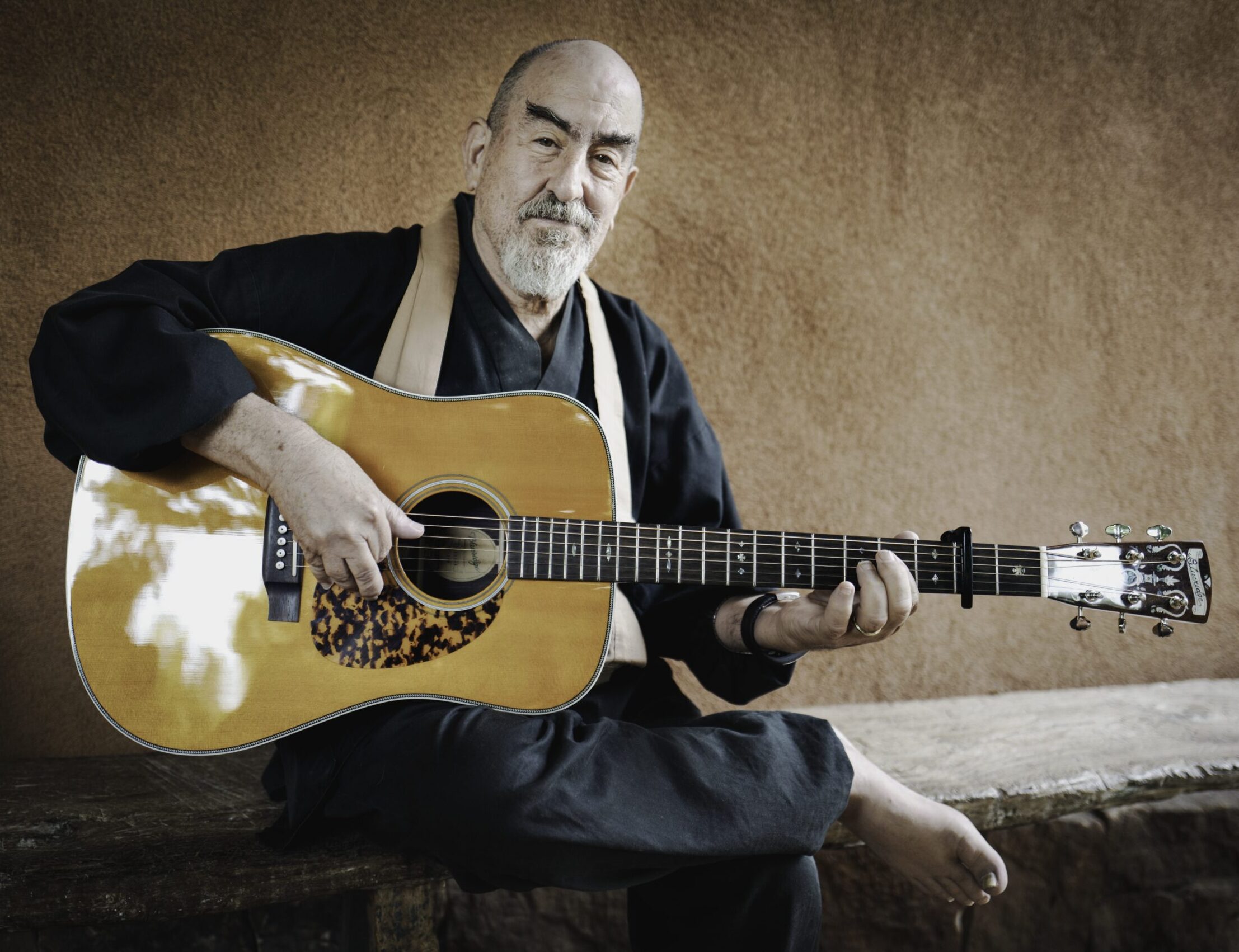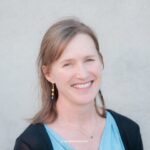As announced here last week, the dharma teacher, activist, author and Berkeley Zen Center abbot Hozan Alan Senauke passed away on December 22. Here, Colleen Morton Busch, author of Fire Monks: Zen Mind Meets Wildfire, offers an in-depth appreciation of Hozan’s life and work.
Hozan Kushiki Alan Senauke, abbot of Berkeley Zen Center, died late in the day on December 22, 2024, in Berkeley, California. He’d suffered a cardiac arrest in December 2023. While he was able to return home and resume some of his abbot duties, he never fully recovered. He was 77 years old.
Hozan helped Berkeley Zen Center (BZC) maintain stability and a depth of practice during a time of grief and uncertainty. He became abbot in January of 2021 during the covid pandemic, after the first abbot and founder of BZC’s death. Whether you called him by his dharma name (Hozan) or knew him as Alan depends on which circle of his life you were part of — and there were many circles, overlapping in resonant harmony.
Born in Brooklyn, New York on Dec 13, 1947, to Lillian Weiss Senauke Stein and Isaac “Lish” Senauke, Hozan grew up in a secular Jewish family, the eldest of five children. He was attuned to matters of social justice early — a Bob Dylan doppelganger strumming protest songs on his guitar and bussing to Washington D.C. in 1963 for the March for Peace and Freedom, where he heard Dr. Martin Luther King’s “I Have a Dream” speech.
Because of his inquiring mind and the microscope and specimens he kept in his childhood bedroom, Hozan’s family assumed he would pursue a career in science or medicine. But he was equally a connoisseur of literary classics and R. Crumb comics. He studied English at Columbia, where he was deeply affected by the teaching and poetry of Kenneth Koch and co-edited The Columbia Review with fellow student writer Hilton Obenzinger.
The seeds of Hozan’s activist impulses and commitment to social change were watered in 1968, when he was beaten and arrested along with more than 700 other students during a weeklong nonviolent occupation of the university president’s office in Low Library. The students were protesting the university’s complicity in military research to aid the Vietnam War and the racial implications of its plans to build a gym for a private university in a public Harlem park. In negotiations during the strike, Hozan was selected as the representative of “Low Commune,” the group of students occupying the president’s office. He persuaded the Grateful Dead to perform on campus in solidarity with the students. He later wrote of the experience that it had “the power to turn poets into lifelong activists.” After graduating from Columbia, Hozan married fellow protester Nancy Werner. The couple divorced a few years later but remained friends.
In the San Francisco Bay Area later in 1968, Hozan was exposed to Soto Zen practice at San Francisco Zen Center and BZC, both established with the guidance of the late Shunryu Suzuki Roshi, author of Zen Mind, Beginner’s Mind. But it wasn’t until the early 1980s that he found his home, with his teacher, BZC founder Hakuryu Sojun Mel Weitsman. Hozan moved in, became a priest, married fellow Zen student Laurie Schley, and raised a family.
Hozan Kushiki, the name Alan was given by his teacher, means Dharma Mountain, Formless Form. Demonstrating his characteristic insight and nimble wit, he later wrote that he chose to go by Hozan rather than Kushiki because he wasn’t comfortable being known as Mr. Formless Form. Though he was a penetrating thinker, his way as a teacher, and a parent, was not to pressure or direct. He asked questions. He listened. But when his daughter took up mandolin and his son dove into Zen, two of his life’s treasures, he was happy and proud.
During his tenure as abbot, Hozan led BZC collaboratively, fostering inclusivity and working to skillfully address privilege, bias, and what he called “systems of suffering.” He cultivated interfaith partnerships and a new generation of leadership, supporting women teachers and helping young and diverse practitioners take up Zen practice. Previously, he’d served as president of the Soto Zen Buddhist Association and taught in the Buddhist chaplaincy program at Upaya Zen Center in New Mexico. He facilitated meditation behind bars at the now-shuttered women’s federal prison in Dublin, California, protested capital punishment in the fog and rain outside San Quentin state prison, and befriended writer and Buddhist practitioner Jarvis Jay Masters, an innocent man on death row.
Hozan served as executive director of the Buddhist Peace Fellowship from 1991 through 2001. Attending the general conference of the International Network of Engaged Buddhists (INEB) in 1991, he traveled to the headquarters of a student and ethnic rebel alliance on the border of Thailand and Myanmar. When the village was bombed by the government air force during his visit, Hozan experienced firsthand the visceral suffering of people living under military dictatorship. He made more border visits over the years, sometimes clandestinely, and collaborated with an American Theravada Buddhist monk, the Venerable Bhikkhu Bodhi, to support young, engaged Buddhists in Myanmar and Bangladesh.
Hozan was also instrumental in efforts to define Buddhist social engagement and develop clear critiques of modern society through a Buddhist lens. These efforts grew into Think Sangha, a collection of activists and thinkers exploring creative solutions to social issues like economic globalization, consumerism, and technology. He took part in the World Faiths Development Dialogue, a series of World Bank conferences that gathered international religious leaders to reframe the meaning of development not solely in economic terms.
During this period, Hozan’s bodhisattva path snapped into focus for him. (A bodhisattva, in Mahayana Buddhism, defers his or her awakening until all beings are awakened.) A natural networker, his was a boots-on-the-ground activism, and he traveled abroad frequently to meet with Buddhist communities. In the early 2000s, Hozan became involved with Dalits in India — former “untouchables” who followed their leader Dr. B. R. Ambedkar into leaving the Hindu caste system behind and taking up Buddhist practice. In 2007, he formed Clear View Project, a nonprofit providing material relief and connecting Buddhists in North America with movements for social change in Buddhist Asia. He was especially beloved by his many students at the Nagaloka Training Institute in Nagpur, India, whom he taught to apply the Buddha’s and Martin Luther King’s teachings to their lives—and entertained on his guitar.
An accomplished professional musician, Hozan’s musical career began in the 1970s, touring and recording with the Fiction Brothers and editing the folk music magazine Sing Out! From the early 1980s, he toured nationally and internationally and recorded acclaimed albums of bluegrass, old-time, Cajun, and children’s music with Blue Flame String Band, Michael Doucet & Danny Poullard, Eric Thompson, the Bluegrass Intentions, High Country, and Gerry Tenney. Alan collaborated with many notable Bay Area musicians, including Ray Bierl, Kathy Kallick, Suzy Thompson, Jody Stecher, and Kate Brislin, and taught aspiring musicians at several camps. He released two Buddhist-infused albums, Wooden Man: Old Songs from the Southern School and Everything is Broken: Songs about Things as They Are.
Hozan authored several books in which he shared his lived understanding of the dharma: Heirs to Ambedkar: The Rebirth of Engaged Buddhism in India (Clear View Press), The Bodhisattva’s Embrace: Dispatches from Engaged Buddhism’s Front Lines (Clear View Press) and Turning Words (Shambhala). A bodhisattva’s path is not easy. It requires stepping out of one’s zones of comfort and knowing. At times irritable, impatient, and self-doubting, Hozan took refuge in the Buddha’s teachings, in music and literature, in family and friendship — and in simple pleasures like watching old movies on the Criterion channel. In a powerful 2012 piece in Inquiring Mind, later excerpted in Buddhadharma, he shared the teachings found in his personal experience with depression and anxiety: “There is a message in depression. Things in life are roiling. Change is afoot. After years of practice I sense this even in hard times. If I can bear it, see through it, depression becomes the harbinger of transformation.”
Lines from an early poem Hozan wrote about zazen (zen meditation) — “The walls step back and lie down/ When I sit” — point to the powerful recognition of the truth of no separation, especially when that recognition is carried off the cushion into the troubled wider world. Awakened activity, he believed, is asking, How do I want to act in the face of this? Violence was never his answer. “I am unwilling to kill or harm another person in the service of my beliefs,” he wrote in The Bodhisattva’s Embrace. Hozan taught that turning towards suffering is to become truly human, and that impermanence, often the cause of suffering, can be a source of comfort. In the last year of his life, bed-bound but with heart and mind burning bright, he drew on these teachings to meet his difficult circumstances and received an outpouring of love and gratitude that he found astonishing.
Hozan leaves behind five dharma heirs and many students and friends in the global Buddhist community. He is survived by siblings Suzie Senauke Laskin, Scott Senauke, Lisa Senauke, and Tracey Stein West, wife Laurie Schley Senauke, also a transmitted Zen priest, daughter Silvie Senauke (Cooper Long), and son Genpo Alexander Senauke.
Condolences can be sent to the Senauke family and the BZC sangha c/o Berkeley Zen Center, 1931 Russell St., Berkeley, CA 94703. A memorial is being planned, and details will be announced when available.
A version of this obituary also appears on Legacy.com.


